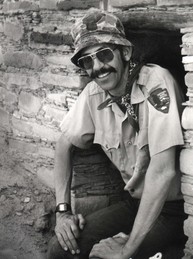Wood has always told a story. Whether it’s the whittling of lovers’ initials, the mashing of wood pulp into paper, or the dating of tree rings; in its variety of forms, wood has long been a medium to preserve history’s story.
The latter, tree-ring dating or dendrochronology, is the method of choice for Archaeologist Thomas Windes when piecing together the puzzle of the Southwest’s ancient civilizations.
On Thursday, July 17th at 6 p.m., the Moab Information Center will host Windes for its latest installment of its summer lecture series. The series is sponsored by long-time supporter of Windes’ work – the Canyonlands National History Association (CNHA).
With more than 90 published articles over his 40-year career as an archeologist, Windes’ contributions to the field have been essential in understanding the mysterious disappearance of the Anasazi. The focus of Thursday’s discussion will revolve around one of the perilous parts of the job: the excavation of defensive cliff dwellings.
To explain the stresses leading to the need for these defensive structures, Windes will decipher the story of the wood used in their construction.
“I also want to explain a bit about the information we can get from specific documentation of the structural wood at sites because it is the most valuable cultural material at a site, providing a wealth of potential information besides the dating: species, forest conditions, potential impacts to the local woodlands, harvest preferences and availability, harvest cutting styles, use, climatic information, and the potential for marking the date of harvest down to a month or so,” Windes said. “This aspect of recording has seldom been done in the past and has allowed much invaluable architectural and environmental information to be lost.”
Both Windes and the CHNA consider public discussions like these to be essential in their missions.
CNHA executive director Cindy Hardgrave said the organization’s primary goal is “not just to help construct and preserve the story of this remarkable area, but to relay that story to the public.”
Windes said it would be far more difficult to carry out his work without the public’s financial support and participation.
“I have always greatly relied on volunteers to assist in our work, whether it was excavating sites in Chaco or mapping and documenting sites in Utah and elsewhere,” he said.
Windes said groups like CNHP are important to assist research and other projects that can’t be supported by governmental agencies because of a lack of funding or supporting personnel.
The presentation will last for about an hour, and afterwards the floor will be open to questions and comments. People who would like to learn abouts Windes’ story and work can visit his University of New Mexico profile at www.nmarchaeology.org/about-us/staff/research-associates/tom-windes.html.
Archaeologist to discuss his work on defensive and unusual structures
“I have always greatly relied on volunteers to assist in our work, whether it was excavating sites in Chaco or mapping and documenting sites in Utah and elsewhere.”
What: Moab Information Center Summer Lecture Series, Archaeologist Thomas Windes
When: Thursday, July 17, 6 p.m.
Where: Moab Information Center, 25 E. Center St.




